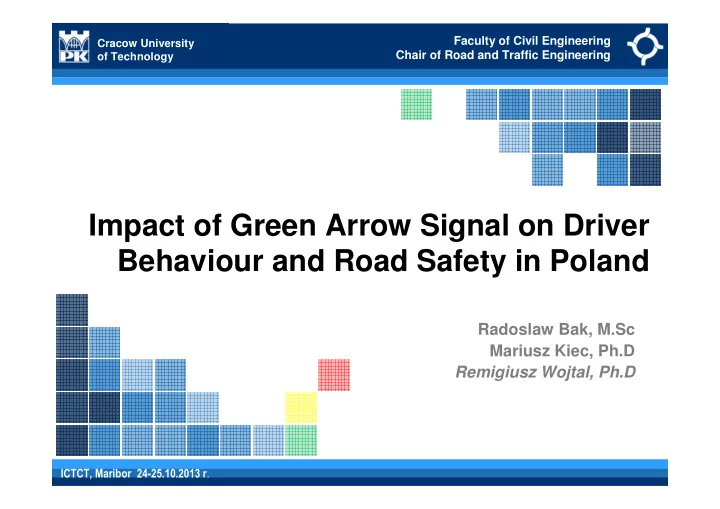

Faculty of Civil Engineering Cracow University Chair of Road and Traffic Engineering of Technology Impact of Green Arrow Signal on Driver Behaviour and Road Safety in Poland Radoslaw Bak, M.Sc Mariusz Kiec, Ph.D Remigiusz Wojtal, Ph.D ICTCT, Maribor 24-25.10.2013 r .
Overview of presentation • Introduction • Idea of Green Arrow Signal (GAS) in Poland • GAS safety and operation problems in Poland • Methodology of analyses – Accident database – Driver’s behaviour study – Conflict analysis • Results • Conclusions
Aim of the analyses • Identification of safety hazard and operation problem related to green arrow signal • Assessment of possibility of VIVDS application
Green arrow signal (GAS) • Allow to turn right (or left) when red signal is displayed, usually under special conditions (after giving a right of way or/and complete stop) Germany Poland Spain Czech Belgium Republic
Green Arrow Signal in Poland TS: HC: Complete stop Arrow-shaped sign before stop bar 1 st definition of GAS becomes necessary TS: GAS must be changed to protected mode (non-collision) Since 2009 GAS may operate in: Since 2009 GAS may operate in: � permissive mode � permissive mode � protected mode � protected mode � permissive-protected mode � permissive-protected mode TS: Restoration of technical standards from before 2003
GAS safety and operation problems • Changes in law regulations and technical standards has been done without safety analysis • Political issue • Commonly recognized as unsafe, especially for pedestrians and cyclists • Low drivers’ propensity to adjust to law regulations
GAS safety and operation problems • No reliable accident analysis • Incomplete accident data (PDO are not thoroughly underreported) • Lack of empirical research
GAS Conflicts • vehicle-vehicle: – Through movement – Left turn – U-turn • pedestrian • cyclists • public transport
Methodology • Application of three method techniques used in GAS (RTOR) safety research: – Accident analysis – Drivers’ behaviour – Traffic conflict technique
Accident analysis • Accidents with pedestrians and cyclists in Cracow on signalized intersections (2 year accident database) – 152 accidents • Driver fault/error (109 acc. => 72%) Entrance crosswalk Crosswalk on exit Green signal GAS Right turn Through Left turn (protected) (permissive) (permissive) (protected) (permissive) 6 9 8 8 19 Left 7 10 27 9 6 Right 13 (12%) 19 (17%) 35 (32%) 17 (15%) 25 (23%) Both
Accident analysis Right turn (permissive mode) 8 8 9 9 8 8 6 6 Crosswalk on exit (protected mode) 27 27 Crosswalk on entrance Right turn 19 19 (protected mode) (GAS) 6 7 9 6 10 7 9 10 Left turn Accidents with (permissive mode) Accidents with cyclists cyclists
Drivers’ behaviour P1 Protected mode P2 Permissive mode / possible v-v conflicts P3 Permissive mode / possible v-v, v-p, v-c conflicts P4 Permissive-protected mode / collision may occur in particular stages Green arrow indicated Red only correct no stopping / GAS not used Entering red Entering red Entering red entering yield to after yellow after GAS pedestrians signal P1 2,8% 75,4% 2,0% 8,1% 11,7% 19,8% P2 1,6% 74,8% 1,9% 11,3% 10,3% 21,6% P3 1,7% 58,8% 3,4% 23,5% 12,6% 36,1% P4 2,0% 64,6% 2,0% 18,7% 12,7% 31,4%
Conflict analysis • Conflict observations (v-v, v-p, v-c) on high-volume intersections with GAS-permissive mode in Cracow. • Multiple measurements with video recording in peak period on 4 intersections (2 with shared lane for right movement) Opolska Meissnera Półłanki Łokietka (urban) (urban) (suburban) (suburban)
Conflict analysis Vehicle–Pedestrian / Cyclist Conflicts CP1 Sudden vehicle and pedestrian stop CP2 Sudden vehicle stop before crosswalk Failure to give a right of way to pedestrian – pedestrian is stopped CP3 on crosswalk Failure to give a right of way to pedestrian – pedestrian can not CP4 enter crosswalk Vehicle stops on crosswalk – pedestrians have to come around CP5 vehicles CP6 Vehicle goes through pedestrian group
VIVDS conflict analysis • Video imaging vehicle detection systems are commonly used for detecting traffic at intersections • Is there possibility to apply standard VIVDS technology to estimate GAS safety hazard?
VIVDS Preliminary research • VIVDS application: – Detector layout – Detection accurancy – Surrogate safety measures
VIVDS Preliminary research • VIVDS seem to be difficult to obtain classical SSM like Time to Collision or Post-Encroachment Time
Conclusions • Analysis conducted on few intersections in Cracow indicated problems with GAS: – despite the lack of enough data – Drivers don’t obey • Drivers have problems with adjusting to law regulations contributing to the safety issues
Conclusions • Assessment of safety analysis requires use of traffic conflicts technique: – due to limited accident database it can be the only method to develop how to operate and design of GAS • VIVDS has limitations and needs further developments but it seems effective tool in safety analysis – need for proper calibration of system – need for new SSM
Thank You !!! Radoslaw Bak: rbak@pk.edu.pl Mariusz Kiec: mkiec@pk.edu.pl Remigiusz Wojtal: rwojtal@pk.edu.pl 21 21
Recommend
More recommend